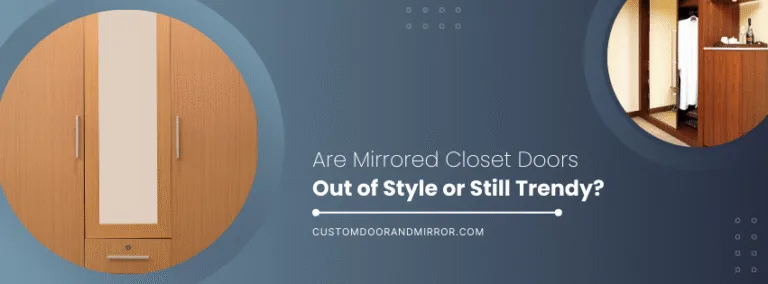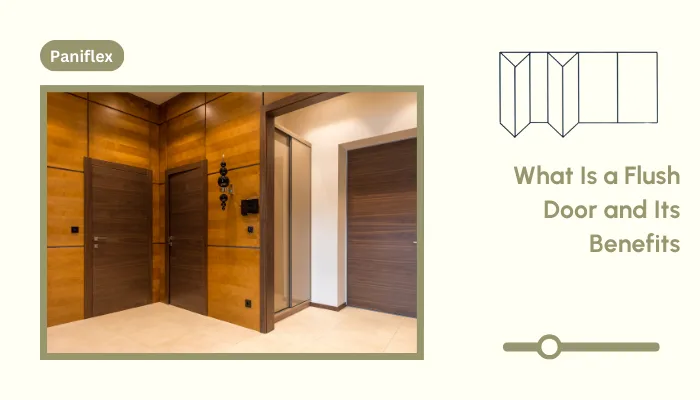Bifold doors are a favorite in modern interiors for their ability to save space while adding style and functionality. From closets to room dividers, their sleek folding design makes them a versatile choice for residential and commercial projects alike.
Property owners tend to appreciate the look but rarely understand how these doors actually work. We understand how important it is to explain the style and the mechanics behind bifold doors so owners can feel confident in their investment.
In this guide, we break down how bifold door mechanisms function, their advantages, and the key considerations for ensuring smooth and lasting performance.
Ready to experience the benefits of custom closet doors? Explore our range of Paniflex products now.
Here’s the short version:
- Bifold doors operate through a system of tracks, pivots, hinges, and rollers that allow panels to fold neatly to one side, maximizing usable space.
- Understanding how the mechanism works helps designers, architects, and contractors ensure smooth performance and client satisfaction.
- When properly installed, bifold doors offer space efficiency, wide access, and versatile design options for both residential and commercial settings.
- Common challenges include misalignment, track wear, and noisy operation, but these can be resolved with quality hardware and regular maintenance.
What Are Bifold Doors?
Bifold doors are space-saving doors made up of two or more panels connected by hinges, designed to fold neatly to one side when opened. Their efficient operation makes them a practical yet stylish solution for both residential and commercial interiors.
Characteristics of bifold doors are:
- Panels fold together instead of swinging outward, making them ideal for compact areas.
- It can be installed in closets, laundry rooms, pantries, and as room dividers.
- Provide wider openings compared to traditional hinged doors.
- Available in a range of materials and finishes, from mirrored panels to solid MDF.
To understand why bifold doors perform so effectively, it helps to look closer at the components that make up their unique mechanism.
Suggested Read: Fixing Squeaky Bi-Fold Doors: Solutions and Tips
Core Components of a Bifold Door Mechanism
The smooth function of bifold doors relies on a combination of carefully engineered parts. Each component plays a key role in ensuring the doors open and close with ease while maintaining alignment and durability.
These are the essential components of bifold doors:
1. Tracks and Rails
Tracks, placed at the top or bottom, guide the movement of the panels. They provide stability and ensure the doors slide evenly without wobbling or dragging. Tracks are best installed within steel beams.
2. Pivot Points
Located at the ends of the panels, pivot points anchor the doors while allowing them to fold smoothly. They help distribute weight evenly, reducing stress on hinges and tracks.
3. Hinges and Connectors
Hinges link the panels together, enabling the folding action. Quality hinges ensure a tight, seamless fold while preventing gaps that could disrupt the clean look of the door.
4. Rollers and Guides
Rollers glide along the track, minimizing friction for effortless movement. Guides keep the panels aligned, ensuring consistent performance and preventing misalignment over time.
With the main components in place, the next step is understanding how they work together. Let us walk through the folding mechanism step by step.
Suggested Watch: Watch this video to understand how bifold door hardware works.
How the Folding Mechanism Works Step-by-Step

Bifold doors open and close through a coordinated system of tracks, pivots, and hinges. This design allows the panels to fold neatly, saving space while providing wide, easy access.
This is how the folding mechanism works:
Step 1: Anchoring with Pivot Points
The folding action begins with the pivot points, which are positioned at the ends of the panels. These pivots hold the first panel securely in place, ensuring the structure remains stable as the doors move. By anchoring the panels, they provide the balance needed for the folding motion to begin without unnecessary strain on the hardware.
Step 2: Guiding Along the Track
Once the pivots are secured, rollers glide smoothly within the track to guide the panels. The track ensures that movement stays aligned and controlled, preventing the doors from shifting off course. High-quality tracks and rollers reduce friction, which not only allows for quiet operation but also extends the lifespan of the hardware.
Step 3: Folding Through Hinges
As the panels move along the track, the hinges connecting them enable the folding motion. These hinges allow the panels to fold toward each other instead of swinging outward, which is what makes bifold doors so space-efficient. The hinges must be precisely installed to prevent gaps or uneven folding that could disrupt the look and operation.
Step 4: Stacking Neatly to the Side
Finally, the panels fold completely against each other, creating a compact stack at the side of the opening. This allows the maximum width of the doorway to remain accessible without requiring additional clearance space. The neat stacking makes bifold doors especially useful in tight layouts, closets, and transitional spaces. When done correctly, the fold feels effortless and adds to the overall elegance of the room.
Of course, even the best mechanism depends on proper installation. Next, let us look at the essential tips to ensure bifold doors operate smoothly and maintain their quality over time.
Suggested Read: Alternative HVAC Closet Door Size for Furnace Room
Tips for Correct Installation of Bifold Doors
Even the highest-quality bifold doors can underperform if installation is not precise. For designers, architects, and contractors, following best practices ensures smooth operation, long-term durability, and client satisfaction.
Helpful tips include:
- Take accurate measurements of the opening to avoid gaps or misalignment.
- Ensure the frame is square and level before fitting tracks and panels.
- Use heavy-duty tracks and rollers suitable for the door’s weight.
- Secure pivot points firmly to provide stable anchoring.
- Test door movement during installation and adjust hinges or tracks as needed.
Correct installation sets the foundation for reliable performance, but continued care is just as important. Simple maintenance practices can help bifold doors stay smooth and stylish for years to come.
When properly maintained, bifold doors bring style and functionality to a variety of spaces. However, issues can always arise. The next section provides detailed troubleshooting tips.
From the Community: Read more about fixing bifold doors that stick or jump the track in this Reddit thread.
Troubleshooting Bifold Door Mechanisms

Bifold doors can present issues if not chosen, installed, or maintained properly. Knowing the common challenges and how to resolve them helps ensure they perform smoothly and remain durable over time.
These are a few mistakes to be aware of:
1. Misalignment Issues
Over time, bifold door panels may shift slightly, leading to uneven gaps or panels that do not close flush. This often happens when pivot points loosen or tracks are installed incorrectly.
Solution: Regularly check pivot points and adjust hinges or tracks to keep the panels aligned.
2. Track or Roller Wear
Because bifold doors rely heavily on rollers and tracks, these parts can wear down with frequent use. Worn tracks cause jerky movement or doors that stick instead of gliding smoothly.
Solution: Use high-quality ball-bearing rollers and lubricate them periodically for long-lasting, smooth movement.
3. Out-of-Square Openings
In many older homes or buildings, openings may not be perfectly square, making it challenging to fit bifold doors. This can lead to stress on the hinges and tracks, reducing performance over time.
Solution: Opt for adjustable hardware that can compensate for uneven openings and ensure a proper fit.
4. Noisy Operation
Squeaks, creaks, or grinding noises can occur when hinges and rollers are not properly maintained. Dust buildup or a lack of lubrication can exacerbate the problem over time.
Solution: Apply silicone-based lubricants to reduce friction and check for loose fittings.
5. Limited Durability
Inexpensive bifold doors may look appealing initially, but they often use weaker materials and low-grade hardware. These systems may quickly show signs of wear, such as sagging panels or peeling finishes.
Solution: Invest in durable materials and hardware designed to withstand frequent use.
By addressing these challenges early, you can ensure bifold doors remain both stylish and practical. Now, let us explore the ideal locations where bifold doors truly excel.
Ideal Locations for Bifold Doors
Bifold doors are valued for their ability to maximize space and provide versatility, making them a wise choice in both residential and commercial interiors. Their folding design allows for creative use in areas where traditional doors may not be practical.
Practical applications include:
- Closets and Wardrobes: Perfect for bedrooms and hallways, bifold doors provide full access without requiring large swing clearance.
- Pantries and Laundry Rooms: Their compact fold makes them ideal for tight utility spaces where efficiency is key.
- Room Dividers: Bifold systems can separate living or office areas without permanently closing off light or space.
- Commercial Storage Areas: In offices or retail spaces, they allow easy access to supplies while keeping storage neatly concealed.
- Balcony and Patio Entrances: Large bifold panels create a wide opening, seamlessly connecting indoor and outdoor areas.
While these locations highlight the versatility of bifold doors, their performance ultimately depends on the quality of the hardware and design. This is where Custom Door & Mirror makes a real difference.
Suggested Read: Locking a Sliding Closet Door: A How-To Guide
Innovative Solutions from Custom Door & Mirror
Not all bifold doors are created equal. At Custom Door & Mirror, we combine decades of expertise with modern technology to deliver bifold door systems that are durable, stylish, and built for seamless everyday use.
These are a few reasons why interior designers, architects, and contractors prefer our custom doors:
1. Precision Custom Sizing
Every bifold door is made to exact measurements, ensuring a perfect fit without the need for costly alterations. This attention to detail guarantees smooth operation and a polished, professional finish in any setting.
2. TruClose™ Cam-Hinge System
Our patented TruClose™ hinges ensure doors close softly and securely every time. This advanced mechanism eliminates slamming, reduces wear, and provides lasting stability for both residential and commercial projects.
3. Durable Ball-Bearing Rollers
Equipped with heavy-duty ball-bearing rollers, our bifold doors glide quietly and effortlessly along their tracks. These rollers are designed for long-term performance, even with frequent daily use.
4. Wide Range of Panel Options
From mirrored panels that brighten spaces to solid MDF with custom routed designs, we offer finishes that complement any interior style. Our selection makes it easy to match design themes while maintaining functionality.
5. Proven Track Record
With over 60 years of industry experience and more than a million installations, Custom Door & Mirror remains a trusted partner for designers, architects, and contractors across the nation.
Custom Door & Mirror delivers bifold door solutions that go beyond basic functionality, serving clients across Long Island (Nassau and Suffolk County), Queens, Brooklyn, Manhattan, the Bronx, Staten Island, New Jersey, and Connecticut. Our products give professionals the confidence to specify doors that enhance both the performance and style of every project.
Ready to experience the benefits of custom closet doors? Explore our range of Paniflex products now.
Conclusion
Bifold doors remain one of the most efficient and versatile options for modern interiors. Their folding mechanisms maximize space, provide wide access, and adapt easily to both residential and commercial applications when installed and maintained correctly.
At Custom Door & Mirror, we enhance these benefits with precision custom sizing, the patented TruClose™ cam-hinge system, durable ball-bearing rollers, and a wide range of panel options to suit any design style. With over 60 years of experience, our solutions are trusted by professionals nationwide for lasting quality and seamless performance.
Ready to upgrade your next project with bifold doors that strike a perfect balance between form and function? Contact us today to explore bulk order solutions tailored to your design needs.
Frequently Asked Questions
Q1. How do bifold doors operate?
Bifold doors operate using a system of pivots, hinges, and rollers that allow the panels to fold neatly to one side. Tracks guide the movement, ensuring smooth operation and maximizing space without requiring large swing clearance.
Q2. What is the locking mechanism for bifold doors?
Most bifold doors use a simple handle with a catch or latch, while larger or exterior bifolds may include multi-point locking systems. These ensure panels stay secure when closed while remaining easy to operate when needed.
Q3. How does a bifold door pivot work?
The pivot anchors the end panel while allowing it to swing and fold with the others. Properly installed pivots distribute weight evenly, maintain alignment, and support the smooth, stable movement of the entire bifold system.
Q4. What is the new trend instead of bifold doors?
Sliding and pocket doors are gaining popularity as alternatives, offering sleek designs that disappear into walls or glide along tracks. They provide a minimalist look while saving space, though bifold doors remain popular for many applications.
Q5. Are bifold doors suitable for commercial spaces?
Yes, bifold doors are widely used in offices, retail stores, and hospitality settings. They allow wide openings for accessibility and storage while keeping spaces organized, making them both functional and appealing in commercial interiors.
Q6. How should bifold doors be maintained?
Regularly clean the tracks to prevent dust buildup, lubricate rollers and hinges with silicone spray, and check pivots for alignment. Annual inspections help identify wear early, ensuring bifold doors continue to function smoothly over the years.






